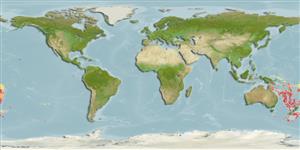Pseudochrysogorgia bellona Pante & France, 2010
| Native range | All suitable habitat | Point map | Year 2050 |

|
| This map was computer-generated and has not yet been reviewed. |
| Pseudochrysogorgia bellona AquaMaps Data sources: GBIF OBIS |
Upload your photos
Google image |
No photo available for this species.No drawings available for Chrysogorgiidae.
Google image |
No photo available for this species.
Classification / Names Common names | Synonyms | CoL | ITIS | WoRMS
Anthozoa | Alcyonacea | Chrysogorgiidae
Environment: milieu / climate zone / depth range / distribution range Ecology
Sessile; depth range 1323 - 1462 m (Ref. 89430). Tropical
Distribution Countries | FAO areas | Ecosystems | Occurrences | Introductions
Western Pacific Ocean: Coral Sea.
Length at first maturity / Size / Weight / Age
Maturity: Lm ? range ? - ? cm
Short description Morphology
Bottlebrush-shaped colony. Monopodial main axis, slightly zigzagging. Branches subdivide into hexagonal patterns. Neck can be narrower than the head. Polyps are as wide as they are tall; mostly leaning distad, if not arranged obliquely on the polyp body. Sclerites in the form of scales and plates mostly parallel to main branch axis present on the coenenchyme branch (Ref. 89430).
Depth range based on data of samples in Ref. 89430.
Life cycle and mating behavior Maturity | Reproduction | Spawning | Eggs | Fecundity | Larvae
Members of the class Anthozoa are either gonochoric or hermaphroditic. Mature gametes are shed into the coelenteron and spawned through the mouth. Life cycle: The zygote develops into a planktonic planula larva. Metamorphosis begins with early morphogenesis of tentacles, septa and pharynx before larval settlement on the aboral end.
Main reference
References | Coordinator | Collaborators
Pante, E. and S.C. France. 2010. (Ref. 89430)
IUCN Red List Status (Ref. 130435)
CITES status (Ref. 108899)
Not Evaluated
CMS (Ref. 116361)
Not Evaluated
Threat to humans
Harmless
Human uses
| FishSource |
Tools
More information
Internet sources
BHL | BOLD Systems | CISTI | DiscoverLife | FAO(Publication : search) | Fishipedia | GenBank (genome, nucleotide) | GloBI | Gomexsi | Google Books | Google Scholar | Google | PubMed | Tree of Life | Wikipedia (Go, Search) | Zoological Record


